From ChinaTechNews -
According to Xinhua News Agency, these figures are for the 2006 Spring Festival holiday:
"China Mobile and China Unicom, the country's two major mobile service providers, users have sent about 12 billion greeting cellphone messages during the Spring Festival holiday. Every mobile phone user sent 30 messages on the average from January 28 to February 4, according to sources from the two companies. Calculating on the basis of 0.1 yuan (1.25 US cents) per short message, China Mobile raked in 950 million yuan (US$118.8 million) from this service, while China Unicom generated 310 million yuan (US$38.8 million). China Mobile alone sent 1.9 billion messages on January 28, or the eve of the Spring Festival, while China Unicom sent 1.4 billion on January 28-29. China Mobile alone sent 1.9 billion messages on January 28, or the eve of the Spring Festival, while China Unicom sent 1.4 billion on January 28-29."
Saturday, June 30, 2007
China SMS Stats for 2006 Spring Festival
Labels: Industry News
Global mobile phone use to hit record 3.25 billion
Per Yahoo News, global mobile phone use will top 3.25 billion, which is equivalent to around half the world's population , in 2007 as cell phone demand booms in China, India, and Africa. The three billion milestone will be passed on July 2007. In comparison, the world's population is forecast to hit around 6.6 billion in July.
Interestingly, it took over 20 years to connect the first billion subscribers, but only 40 months to connect the second billion. More than 1,000 new customers are effectively signing up for mobile phones every minute around the world.
Labels: Industry News
Private Facebook Pages Are Not So Private
From Wired News -
A security researcher has discovered that private Facebook profiles aren't quite as hidden as many users might think they are. Pages that are supposedly restricted are visible to anyone using searches based on religion, sexual orientation or relationship status.
A quick search by Wired News for women in a major U.S. city who were interested in random hookups with men revealed the names and photos of two high school girls, including one ninth grader.
Facebook responded to Wired's inquiry Wednesday evening with an announcement that it had changed the behavior of its privacy settings.
"Facebook offers sophisticated search and privacy controls and is constantly making improvements based on feedback from our users," the spokesman wrote. "We have since updated the advanced search function so that profile information that has been made private by a user, such as gender, religion and sexual orientation, will not return a result."
Labels: Facebook, Social Networks
Friday, June 29, 2007
Why iPhone Won’t Redefine SMS Texting
From iPhonetics -
For all its innovations, Apple’s iPhone has slim chances of making an impact on the way mobile phone users around the world do SMS texting. In two words: QWERTY keyboard. Here’s why:
First of all, even if the Apple goes on to sell 10 million iPhones in the first year as Steve Jobs has predicted, that is just roughly 1% of the nearly 1 billion phones sold annually. You simply can’t redefine a market with such a miniscule share.
Secondly, most of the new market gains are entry level phones sold in third world countries. This implies that most buyers are first time users who in most likelihood have never used a computer before, or if ever, sparingly. Thus, for a lot of them, the mobile phone keypad has become their first exposure to typing. For the younger generation, it is their de facto standard. In fact, a lot has mastered the art of touch-typing on phone keypads. They can enter SMS messages one-handed rapidly into the phone without ever looking at the keypad or the LCD. Somehow I simply can’t imagine them doing the same with the iPhone’s on-screen QWERTY keyboard. The Apple design lends itself to two thumb typing, which is definitely far from the current single thumb texting experience.
Yes, Apple will most likely go on and sell millions of the iPhone as it has previously succeeded with the iPod. But until it adds a physical mobile phone keypad, it most likely will remain a niche play. And when it does add a keypad, it will no longer be redefining the SMS experience but merely improving it.
Labels: Industry Analysis, iPhone, SMS, texting
Digital Divide via Social Networks
Interesting piece from Danah on how the American social classes are reflected in the respective user bases of Myspace and Facebook.
Curiously, I personally feel Faceboook, with all the recent updates and changes, is fast approaching the chaotic look of Myspace. Just my 2 cents.
Labels: Industry Analysis
Apple to launch iPhone in Europe on July 1?
Newswireless is reporting that Apple, in a joint promotion width Vodaphone, T-Mobile (Germany) and Carphone Warehouse, will be launching a 3G version of the iPhone on Monday i the UK. The US version launched today does not support 3G and instead uses the slower EDGE technology.
So where does the line start?
Labels: Industry News
Five Ideas That Will Reinvent Modern Computing
From PC Magazine - Interesting prediction of five future trendsetters. These include -
IMAX at Home
HP Labs is developing Pluribus, a cineplex-quality image using a handful of ordinary, USD1,000 PC projectors—in less time than it takes to pop the popcorn. For a mere USD12,000, you could c a home theater that stands up to the USD100,000 image at local movie houses. And this mega-display is good for more than just movies. It might be even better for 3D games.
The Midair Mouse
Soap goes one step further than the current state-of-the-art wireless mouse: It works in midair. With this new-age pointing device, now under development at Microsoft Research, you can navigate your PC using nothing but a bare hand. You can lose the end table and the lap desk. You can even lose the couch and the bed, driving your machine while walking across the room. It's a bit like the Wii remote—only more accurate and far easier to use. In fact, Soap is so accurate that you can use it to play a high-speed first-person shooter.
But at Bell Labs, they are working on a new quantum computer, a machine which uses a quantum bit, or qubit, instead of the basic bit for storing and processing information. A qubit is not stored not in a transistor but in a quantum system, such as the spin of an atom's nucleus. An "up" spin might indicate a 1, and a "down" spin might indicate a 0.
But thanks to the superposition principle of quantum mechanics, a quantum system can exist in multiple states simultaneously. At any given moment, the spin of a nucleus can be both up and down, holding values of both a 1 and a 0. Put two qubits together and they can hold four values simultaneously (00, 01, 10, and 11). That makes a quantum computer exponentially faster.
But when a quantum system interacts with the classical world, it decoheres: It loses its ability to exist simultaneously in multiple states, collapsing into a single state capable of holding only a single value.
Researchers have long been working on this problem but no major breakthrough has been achieved. Now Bell researchers are working on a new method called "topological quantum computing," which involves tying quantum systems into knots. By tying them into the right knot, they are able to do the right quantum computation. In short, these knots are a great way of solving the decoherence problem - the first to do so.
The classic point-to-point networking model is fundamentally flawed. If you want a piece of data from the network, you almost always need a direct connection to the data's original source—the server. That's true even if the data has already been downloaded to a device that's much closer. So often, tapping into a distant server wastes time. And if the server is unavailable, you're out of luck entirely.
With a project called Content-Centric Networking, PARC networking gurus are turning this model on its head. They're building a networking system that revolves around the data itself. Under the CCN model, you tell the server you want a particular piece of data. You broadcast a request to all the machines on the network, and if one of them has what you're looking for, it responds. It's a bit like BitTorrent, but on a grander scale. CCN can improve everything from the public Internet to your private LAN.
At IBM's Almaden Research Center, a team are chasing the holy grail of artificial intelligence.- they're looking to build one—neuron by neuron, synapse by synapse.
The project is particularly daunting when you consider that modern neurology has yet to explain how the brain actually works. Yes, we know the fundamentals. But we can't be sure of every biological transaction, all the way down to the cellular level. Three years into this Cognitive Computing project, Modha's team isn't just building a brain from an existing blueprint. They're helping to create the blueprint as they build. It's reverse engineering of the highest order.
What's that good for? Anything and everything.Labels: Industry Trends
Thursday, June 28, 2007
The wide world of Sprint's WiMax
From Business 2.0 - An article on outlining plans for Sprint Nextel's upcoming USD3 billion mobile WiMAX network due later this year.
But according to OM Malik on GigaOM, Sprint is apparently rethinking its strategy. Accordingly, it is mulling one or more of these options:
1. Form a joint venture or a partnership with Clearwire.
2. Maybe spin-off the WiMAX business.
3. Attract outside partners like cable companies to co-invest in the WiMAX buildout.
Sprint has had informal talks with Time Warner Cable, its partner in a four-play offering Pivot. However, a potential sticking point is that cable providers want a guarantee that they would be able to lease access to the WiMax network at low cost to offer future broadband services.
Still, this proposal makes most sense when compared to the Clearwire option. Sprint has been hammered on the stock markets, though theprice declines have nothing to do with WiMAX. Instead, Sprint’s misfortunes are directly correlated with massive churn in its cellular customer base. Sprint Nextel’s postpaid gross additions fell 12% in Q1, and revenue grew a meager 5% - leaving investors disatisfied.
The integration problems between Sprint and Nextel are the real reason the former finds itself between a rock-and-a-hard-place. While WiMAX might seem crazy today, it may seem like a minor investment and could dramatically change the future of mobile communications.
Wednesday, June 27, 2007
An effective finger-based keyboard for the iPhone
Found this at Take a Bite -
It would[n't] be fair to just say that the iPhone is unsuited for use while driving due to the lack of a keypad without mentioning why it'll be quite comparable to typing on a physical keyboard for sighted people.
From left to right:
The visual feedback you get from letter magnification combined with 'on release' behavior instead of 'on click' behavior suggest that typing will be a breeze on the iPhone. Multi-touch, or the ability to touch different parts of the display at the same time, means fast two (or more) fingered typing.
----------
I guess the operative word is "sighted" as most teenaged mobile phone users I know these days (except perhaps the ones in the USA) compose SMS text messages without sight - meaning they touch type on the phone's keypad. The phone can very well be in their pocket or their bag. They can even be talking to you, looking at you straight in the eye while their fingers are busy clicking away.
I just don't see how the QWERTY keyboard, on top of the touch feedback, will allow them to replicate the texting experience on the iPhone.
Labels: iPhone
How a six-month-old startup got bought by Google
Interesting how-to item from Business 2.0 -
The article discusses the successful efforts of Wayne Crosby and Robby Walker, who co-founded Zenter to develop an online version of Powerpoint. It was bought by Google even while still in private beta. Helpful tips to other entrepreneurs -
- Don't focus on getting acquired. That's like being a single woman who desperately wants to get married. Of course you want it to happen, but 99% of the time if you purposely try to get acquired (or married), it won't. The way to get acquired really fast is to not focus on it. If people get the impression that you want to get bought, you won't.
- Instead, focus on the user. This is possibly the single most important thing for entrepreneurs to remember. "Every startup that dies fails to do this. A lot of startups focus on their competitors or lawsuits, but what really kills startups is if users think it's boring. It's a much quieter and dangerous reason, but if users don't care about your product, that will just kill a company."
- Ignoring limitations lets you tackle problems from a different angle. Zenter looked at how they could build a slideshow application that really takes advantage of the Internet, like adding community slideshows, delivering presentations online in real-time and dragging and dropping content from the web into a presentation. "Every system and every platform has limitations. Some people look at a problem and say, You can't do that because a browser won't let you and proceed to work around those limitations What we (Zenter) did was look at what we wanted to happen and then found a way around the limitations."
- Don't be afraid to tackle the giants. Big companies like eBay and Microsoft may have more manpower and financial resources, but they also have disadvantages. Often times, they're not as driven. They're not willing to make the sacrifice, like two guys sleeping on air mattresses, to make their product really good. Case in point. Google bought YouTube, which was far superior to Google Video. eBay bought PayPal because clearly, no one was liking eBay's Billpoint. Big companies also have restrictions that startups don't have to worry about. E.g. Microsoft has to think about web-based applications that don't threaten Windows. A company like Zenter doesn't care about hurting Windows. All they want to do is make the best application.
- Pay attention to the details. When your product is 80% done, that means you have another 80% to go. To get something pretty close is easy, but you need to concentration on the little things. That's what will set you apart from the competition. You can have the best algorithm in the world and the fastest process, but at the end if the day, if the user struggles to find out how to click a box or delete something, then you don't succeed.
Labels: Industry Analysis
What is Missing from the iPhone
From Engadget, here is a partial list of what is missing from the iPhone -
- There's no way to cut, copy, or paste text! WHOA! Big, big mistake.
- No A2DP support. That, friends, is such a huge bummer right there.
- Sorry, music can't be used as a ringtone -- even if it's just a raw MP3. No additional ringtones will be sold at launch.
- It supports Exchange in some capacity only.
- Document file reading only -- but not editing -- for PDF, Word, and Excel (only).
- Adobe Flash support is officially out. It's just not in the browser. Neither is there any other kind of embedded video support.
- It will take snaps, but won't record video.
- No MMS.
- No voice dialing, either.
- Contact groups can't be emailed as contact lists.
- iPhone battery capacity maxes out at 300-400 charges -- you'll send it in and get the cell replaced for a fee.
- Voice quality is said to be good -- not great.
Labels: iPhone
A horror movie come to life
From The News Tribune -
Three Fircrest, WA families are being terrorized by mysterious mobile phone stalkers who track their every move and occasionally lurk by their homes late at night, screaming and banging on walls.
What makes it frightening is that the police seem unable to help them. In fact, the families say investigators have a hard time believing the stalkers can control their phones without touching them and suspect an elaborate hoax. Complaints to their phone companies do no good, too – the families say they’ve been told what the stalkers are doing is impossible.
It doesn’t feel impossible to the families, who’ve saved and recorded scores of threatening voice mails, uttered in throaty, juvenile rasps stolen from bad horror films. Despite having caller ID on both land lines and mobile phones, "Restricted" always appears on the screen.
The stalkers seem to know every move the families make. They know what they are eating, when the leave the house, even when they go to baseball gams. They know the color of their clothes, they know when the lock on the door was changed. They even threatened shootings at the schools the children attend.
Somehow, they have gained control of the families' mobile phones. Messages received include snatches of conversation overheard on mobile phone mikes, replayed and transmitted via voice mail. Phone records show many of the messages coming from their own phone, even when it is turned off. The stalkers even knew when they visited the police and sent a voice-mail message that included a portion of their conversation with a detective.
The families have blocked the cameras on their phones with tape. They have taken out the batteries to stop the calls. They have returned all their corrupted phones to their telcos and replaced them with new ones. Yet the stalking continues.
Fircrest Police Chief John Cheesman is familiar with the case and knows the families. His department is working the case with the Tacoma Police Department and the Pierce County Sheriff’s Office. The agencies filed a search warrant for the phone records, but they didn’t reveal much. Many of the calls and text messages trace back to one of the families' mobile phone, which is believed to have been electronically hijacked.
According to the U.S. Department of Commerce, mobile phone technology allows remote monitoring of calls. Known as a “roving bug,” it works whether a phone is on or off. FBI agents tracking organized crime have used it to monitor meetings among mobsters. In addition, GPS, available on many phones, also make it possible to pinpoint a phone’s location within a few feet.
According to a Massachusetts-based counterintelligence agent who has advised the U.S. Congress on security issues, it’s not that difficult to take remote control of a mobile phone. “You do not have to have a strong technical background for someone to do this. They probably have a technically gifted kid who probably is in their neighborhood.”
Labels: Miscellaneous
SanDisk First to Offer 6- and 8-Gigabyte microSDHC Cards
From Business Wire -
June 27, 2007 - Sandisk today announced that it is has begun sampling 6- and 8-GB microSD HC memory cards to major phone manufacturers and mobile network operators for testing and evaluation. The new cards are ideal for the growing number of feature-rich multimedia handsets that bring together phones, music players, hand-held computers, digital cameras and more. An 8GB microSDHC card can store more than 2,000 digital songs, or more than 5,000 high-resolution pictures, or up to 5 hours of high-quality MPEG 4 video.
Retail release of the cards and availability to phone manufacturers and network operators are planned for later in 2007. Pricing has not yet been determined.
Wonder if the Asus Eee 701 PC will support this?Labels: Memory Cards, Sandisk
SMS the iPhone way
With the iPhone getting well over 69 million hits in Google, it is surprising that there is very little discussion on how it deals with SMS texting. Surprising because the iPhone is well a mobile phone. It also does not have a physical keypad. And just as importantly, it processes and presents messages that can be considered a radical departure from the familiar sequential listings in the Inbox, Sent, Log screens established by Nokia.
The iPhone designers are obviously aware that many users often go into texting conversations on the phone, kinda similar to IM chats. So they decided to organize these texting conversations into speech bubbles that can be scrolled back for reference instead of the usual separate Inbox and Sent listings. In addition, mutiple text chats can be stored (by contact name) so that you resume a chain.
This UI will definitely help avid PC IM users transition into text chat on the phone, rather on the iPhone. The question though is just how good is the QWERTY virtual keyboard? I haven't had the chance to do a hands-on but I doubt very much if it can provide a tactile feedback that is often required by users. Personally I feel the keyboard issue will either make or break the iPhone as a mobile phone.
The Hype in iPhone and the Real Test
Give it to Apple to maximize the appeal of its brand cachet. I can’t think of any other tech company which can drum up the media into such a feverish pitch, the New York Times is reporting the iPhone has been the subject of 11,000 print articles and has about 69 million hits in Google. All before its June 29 launch.
Labels: iPhone
Some S60 Nokia Phones Can Run iPhone Safari Web Apps
iFoNfo has reported that some Series 60 Nokia phones with the Safari-based browser can run Web Apps intended for the iPhone. These include the N75, N95 and a Samsung model, the SGH-i520.
But unlike the iPhone, the S60 phones are not limited to web-based applications as these support J2ME and Flash. Future iPhone apps that are based on the Safar UI will likely work with the S60 phones provided the difference in the UI is taken into consideration. The N95 has a 240 x 320 screen compared to the iPhone's 320 x 480.
Future iPhone apps that are based on the Safar UI will likely work with the S60 phones provided the difference in the UI is taken into consideration. The N95 has a 240 x 320 screen compared to the iPhone's 320 x 480.
The iPhone’s touch interface also looks nicer than the typical S60 phone’s method of moving a cursor with a directional pad, but it works well enough for pointing and clicking. Still, it is simply cool to know the phones can run iPhone apps.
Tuesday, June 26, 2007
American Consumers Mainly want WiMAX for On-the-Go E-mail
From Cellular-News -
A Motorola consumer survey reveals that the top four anticipated Internet uses for WiMAX mobile will be email, live news, mobile TV, and music downloading:
● 49% would likely use WiMAX to read or respond to e-mail;
● 31% would read or view "live," real-time online media;
● 28% would enjoy mobile entertainment;
● 28% said they would use WiMAX to download/listen to music.
In the survey, WiMAX was defined as a new, long-range wireless broadband technology that provides secure, high-speed Internet access through a laptop or other device, which can be used in a "fixed" or stationary setting like a home or office.
More importantly, WiMAX was defined as being able to be used while walking or traveling in a car, cab, bus or train, and the Internet connectivity it provides will have the connection speeds of cable or DSL, but with the mobility and roaming of today's cellular networks.
The survey also confirmed what most wireless service providers are counting on: 57% of Internet users think it's important that wireless broadband service be available wherever they may be.
On another level, consumers were asked a variety of questions about how they would most often use wireless broadband. According to the survey, the following scenarios rank among the most popular personal consumer uses of mobile WiMAX:
● 20% of the consumers said they would use Internet-delivered navigation services to get a real-time video view of traffic at major intersections while driving to or from their homes.
● 17% would rely on Internet mobile TV to help entertain restless children in the car while waiting for an oil change or other minor repair.
● 11% would use a mobile broadband Internet connection to check restaurant wait times, menus and daily specials online while coordinating dinner plans with busy friends.
● Internet users also want mobility at work. Of those surveyed:
● 45% would find it beneficial to use WiMAX for reading and responding to e-mail;
● 43% for accessing the Internet for work;
● 33% for accessing their company Intranet to better manage customers, resources and field service;
● 30% for sending data, including pictures or video, from remote sites back to the office.
The survey of 601 USA Internet-using households was conducted by CENTRIS through a national telephone omnibus survey between May 9-15, 2007. The margin of error for the survey is +4%.
Labels: Industry Analysis, WiMAX
North Korea Executes People Caught with Mobile Phones
Just some sobering food for thought -
Cellular-News reports that the North Korean government is executing people caught with mobile phones. In this day and age when so many of take the benefits of mobile communications for granted, it is sobering indeed to learn that elsewhere people are not as fortunate as we are.
According to the report the South Korea-based Korea Institute for National Unification said in a white paper that executions of those who "circulate South Korean leaflets and sell videos and use cell phones are on the rise" without citing numbers.
There are two North Koran mobile phone network but these apparently have been shut down or at least forbidden to the general public following a 2004 train explosion, which some claim was an attempt on the life of Kim Jong-Il.
While no mobile network is presently available to the general public, many phones are smuggled across the Chinese border, where Chinese networks are reported to have unusually strong signal strengths which reaches deep inside North Korean territory.
Labels: Industry Analysis
Sunday, June 24, 2007
iPhone's Lack of Mechanical Keyboard
Well, D-day for Apple's iPhone is fast approaching and the debate re its missing keyboard is heating up as well.
For me, it is simple. Either Apple's brand cachet is enough to overcome the perceived shortcoming and enable the iPhone to become a bestseller or it won't.
If it does, then the iPhone will definitely change user habits and the mobile experience, especially texting. Most teenaged users around the world (except perhaps in the US) have mastered the art of touch-typing on the phone's keypad that it is not unusual for them to text while their phone is in their pocket or in their bag hidden away from either teachers or parents. This is difficult to achieve without the tactile feedback.
But if sales are lukewarm and users decide to wait for the release of a keyboard-equipped iPhone, my guess is Apple will. After all, the mobile phone market is simply too huge for Apple to ignore. More so, the aftermarket of videos and tunes that Steve Jobs wants so much to dominate.
The Human Touch That May Loosen Google’s Grip
Interesting read by Randall Stross from The New York Times re Google and the economics of the Internet search business. Salient points follow -
The most valuable secret formula in American business used to be Coca-Cola’s. Today, it’s Google’s master algorithm. In the search business, however, there’s no rival to play the role of Pepsi. Yahoo is the closest but still a distant No. 2, and Google earns more profits in a single quarter than Yahoo does in a year. Microsoft, an even more distant No. 3 , can’t keep up, despite having USD28B in cash iat the end of March.
The fumbling of Google’s largest challengers, however, has not dampened the enthusiasm of entrepreneurs and venture capitalists for entering the search game. The combination of low start-up costs and potentially huge profit makes it seem a reasonable bet.
Developing a search algorithm can be accomplished by very small teams. It was a team of two — Larry Page and Sergey Brin — who developed a new and improved search algorithm. They beat out Alta Vista, whose search engine was developed by seven people at DEC.
Profit margins in the search business are mind-boggling. Google’s net profit margin last year was 29%. Amazon’s was a mere 1.8%. Even gathering the crumbs left behind by Google could generate a lofty market capitalization. In his blog, Don Dodge, a Microsoft manager argues: “Why 1% of Search Market Share Is Worth Over USD1 Billion.” He reasoned that 1% of the 7.3 billion searches performed in the US alone in March, multiplied by 12 cents in advertising revenue per search, would yield annualized revenue of USD105M. Assuming a market cap that is 10 times revenue, his arithmetic leads to a billion-dollar company.
Another attraction: Any company that offers a superior search service would be able to poach the customers easily. No long-term contracts binds Google users. In addition, even though each search engine conducts a search in its own way, there is no daunting learning curve to prevent users from shifting. Search users merely type in the word or a phrase — no matter which service they are using.
Engines like Hakia, Accoona and Powerset are trying to grab market share by writing a more sophisticated algorithm. A growing number of entrepreneurs are placing their bets, however, on a hybrid system that puts humans back into the search equation. They are grouped under a newly coined rubric, “social search,” and it is becoming a crowded field.
Newcomers like Squidoo, Sproose and NosyJoe offer search results based on submissions or votes by users. Bessed also relies on users to suggest the best Web pages for a topic, but then has editors refine them. ChaCha gives customers the opportunity to have an online chat with a human being who can provide search assistance.
Sometimes a small variation on an existing idea is enough to make it stand out. In Oct 06, when Bessed began its search service with the manually edited results pages, it had only two editors and covered just a few hundred search terms suggested randomly by users.
Last month Mahalo inaugurated a search service with manually edited results. It started with several advantages: VC backing, 30 editors, systematic focus on the most commonly requested search terms, and the added idea of supplying Google’s search results for any search not covered by its own best-of-the-best lists.
Mahalo now has pre-prepared pages for 5K terms related to entertainment, travel, health, technology and other subject areas. It plans to expand its coverage to 10K terms by year-end, and eventually to provide results for one-third of the most common search terms.
The company is financed by Sequoia Capital, an early backer of both Yahoo and Google. Sequoia, like other Silicon Valley venture capital firms, offers experienced entrepreneurs an office and salary to figure out an idea for a new start-up.
It was while he was an entrepreneur in residence that Jason Calacanis,36, thought of Mahalo. He previously published The Silicon Alley Reporter in the mid-90s and went on to be a co-founder of Weblogs, which was sold to AOL in 2005 for about USD25M. He took up residence at Sequoia in Dec 06, founded Mahalo and gathered two rounds of financing, including backing from the News Corporation. He claims to have enough financing to provide five years of experimentation and refinements.
A hand-built Mahalo search-results page has one conspicuous advantage over Google’s: grouping into subthemes, which make a page of links much easier to scan and to find items of particular interest. Mahalo’s page on Paris Hilton, the site’s top search subject last week, lists more than 80 sites, but arranges the recommended links into clusters including news, photos, gossip, satire and humor. The use of subject categories also eliminates the need to provide, as Google does, two-line text excerpts from the listed sites to provide clues about the site’s contents. Thus, they are easier to skim than the 12 sites that fill the entire first page of Google’s search results.
More importantly, all of the links listed in Mahalo send the user to Web pages that contain genuine content, not sales pitches in disguise. By using its own editors as the final arbiters of what goes in, Mahalo cuts off access in its listings to Web sites that confuse a search engine’s algorithm with advertorials that commingle ads with noncommercial information. To those in the trade, outsmarting the algorithm is called “search engine optimization.” For the rest of us, it produces Web pages littered with spam.
Last week, Mr. Calacanis tried to illustrate how spam has infested some top results on Google. After running searches for “low-carb diets,” “Lasik” and “lingerie” at Google and at Mahalo, he compared the results. The exercise succeeded in exposing a few examples of Web sites ranked highly in Google’s results that contained advertorials or content apparently scraped from higher-quality sites.
Google contends that its search engine relies on humans and machines. Matt Cutts, head of Google’s Webspam team, said users who place links on their own Web pages pointing to other sites provide the raw information about valued sites that is incorporated into Google’s PageRank algorithm. But determining the best way to utilize that information requires continuing work by human engineers.
Thus at Google the machine has the final say. Once the query is fed into the “engine,” the results are presented without manual adjustment. At Mahalo and other “human powered” sites, the machine performs a first cut at the search in advance of a user’s request, and the results are then winnowed and shaped by human editors, then stored, a process that Mr. Calacanis terms “editorialized search.”
HUMAN-POWERED search may be able to cover a wide swath of queries if it can draw on the enthusiasm of contributors who have made Wikipedia a phenomenon of huge scale. Mahalo just began a “Mahalo Greenhouse” service that enlists users who are passionate about a particular subject to write a page of search results for USD10 to USD15. Submissions must pass the scrutiny of the site’s full-time editors before posting.
Even Google is interested in exploring “human powered” search. It has combed through its own Web pages to remove all references to “automatic ranking” to prepare for the possibility of relying on user feedback to improve search results or other approaches that are more directly “human powered” than the algorithm.
Labels: Industry Analysis
Boingo To Offer Monthly Flat-Rate Service
The New York Times reported on June 24 that Boingo Wireless, one of the biggest aggregators with more than 100K hot spots, is introducing the first worldwide flat-rate plan for Wi-Fi hot spots. For a monthly fee of 29 euros, or USD39, subscribers can use any of the company’s affiliated hot spots for as long as they want. No particular software is needed, though Boingo recommends that clients download GoBoingo, a program that alerts users when they are in range of a Boingo hot spot. Boingo directly runs wireless networks at 13 of the largest North American airports, including the three in the New York area and the two in Chicago. As an aggregator, the company also allows subscribers access to 27,000 hot spots in North America, 23,000 in Asia and 51,000 in Europe, the Middle East and Africa that are owned and operated by companies like Earthlink, BT, Verizon, Sprint Nextel, and Telecom Italia.
Last year the number of hot spots accessible to the public rose 17% in New York, 37% in Paris and 27% in London. Boingo also offers an unlimited monthly flat rate for smartphones and PDAs at USD7.95. Boingo’s competitors already have plans to start their own flat-rate service.
For more info on Boingo's service, go to www.boingo.com.
Labels: Boingo, WiFi Hotspots
Compal showcases prototype UMPC running Windows CE
From Engadget -
Compal introduced at Computex the UMPC prototype running Windows CE 5.0 called the UMD (Ultra Mobile Device). It is also a smartphone equipped with HSDPA and features a 532MHz Freescale i.MX31 processor, 512MB of NAND Flash memory, 256MB of DDR RAM, a 4.3-inch WVGA display, 802.11b/g WiFi, Bluetooth 2.0+EDR, a slide out QWERTY keyboard, trackpad, hot keys, built-in speaker and microphone, a 1.3-megapixel CMOS camera, SIM card slot, a miniSD slot to hold excess media, USB connectivity, and a headphone jack.
It also supports media playing and Skype.
Battery life is rated at 5 hours (only???).
The company has not announced release date.
Labels: Compal UMD, Mobile Devices, UMPC
Saturday, June 23, 2007
Mobile Ubuntu, anyone?
From Engadget -
Ubuntu 7.10 (Gutsy Gibbon) will be the first Ubuntu release to include mobile and embedded editions, targed at hand-held devices and other mobile/embedded form factors. Wtih a 2.6.22 Linux kernel, the new version will integrate components from Nokia's Hildon UI. The UI was first used on the N800 tablet.
Given the above, it looks like the video (screen cap from Engadget is shown below) showing an SE P990i running Ubuntu most likely isn't a hoax after all. So the countdown begins - October 18th is the scheduled release.

Labels: Mobile Linux, Mobile Ubuntu
Tuesday, June 19, 2007
Insider's Tips on Dealing with Dell
Over at the Consumerist, a former Dell sales manager shared some tips re dealing with the company. Some of the more useful ones are:
1. Small business is better than home and home office - Small business typically runs a few dollars more than the home office, but you stand a better chance of getting domestic tech support rather than non-native English speakers. As an added perk, small business promotions are occasionally better than home.
2. Play with the web site - There are many different pricing packages for the same product throughout the various sections, typically three or more per segment. If you're buying a Dell soon, configure a unit from a link off the main page, from the product listing on the drop down and from the "As Advertised-Newspaper" drop down. Configure the same system each way at the home, small business and the Direct (kiosk) site (http://www.dell.com/directstore). It is very likely you will end up with nine different prices.
3. Tech support web site - If you're having a common problem, hit the product forums (however crippled they may be now). It is very likely your question/problem has been resolved before, and usually a domestic tech rep posted a solution there.
4. Warranty Repairs - On all but the two lowest warranties (90 day and 1 year limited), warranty repairs will be done in the home. The repair techs are only required to replace the broken part. They are not required to do anything else. If they replace your hard drive, they are not required to reinstall your OS or drivers. Most will do it if you're nice, but don't expect it. If you're clueless, there are tutorials all over http://support.dell.com that tell you how to do it yourself.
UPDATE: Current Dell rep says: Also with desktop machines at home service is the only option. Notebooks on the other hand may have a return to depot or an at home service contract.
5. OS Backup Disk - For over a year now, Dell has required you to purchase your Backup/Reinstall Disk. Order this with your machine. Once your Dell is delivered, it is a pain to get the disk at all, much less at a sensible price. If you do not have this disk and your hard drive dies, at home warranty repair will not be able to get your PC running once the drive is swapped without selling you a new copy of your OS.
UPDATE: Current Dell rep says: Dell no longer requires the purchase of the backup disk. They are included with every computer that ships with a Windows OS. On the subject of hard drives, if your drive fails within the first year of purchase you should be sent an imaged drive that will contain everything except for your royalty applications (Office etc). If for some reason you lose the media, you can request the OS, Resource/Drivers disk, and the applications disk at no cost to you. (Even if you are no longer under warranty Dell will send you an OS disk) Note that the Resource/Drivers and Applications disk is only available for currently shipping systems. Should you need to reinstall you'll need to download the drivers from support.dell.com from another computer and copy them over. Last, within the first year of purchase, if you need to reinstall the OS and you can't access the recovery image, or if it was deleted for some reason, you can request an System Recovery CD that does pretty much the same thing. (Not available on notebooks due to the Media Direct partition.)
6. Promotion cycle dates - Thursday is the first day of new promotions. If you go to the web site at 11:45 p.m. on Wednesday night and again on 1 a.m. on Thursday morning, the promotions are different. The catalog promotions run from the start of the month to the end. Additionally, on holiday weekends (Memorial Day, 4th of July, etc.) there may be special sales/coupons for the three-day weekend.
7. Promotion styles - Typically, one week will be cash off while the next will be percentage off. If you liked cash off but the current promotion is percentage off, check the "As Advertised-Newspaper" section. These typically have a remnant of the prior week's promotion as well as better versions of the current week's promotions. Cash off helps for cheap systems, percentage off helps with high-end.
8. Dell Customer Care can price match within 24 hours from the time of order. Combining #1 and #2 from this section, if you are unsure of the value of the week's promotion but need to order something, order it Wednesday night. Check the promotions for the new week on Thursday. If it's better, call and price match. If it's not, sit back and feel smug for no reason.
9. Dell corporate email - As of December 2006, everybody (save Michael Dell) working for Dell U.S. has the same form of email address: firstname_lastname@dell.com. Michael Dell's does not follow this pattern and is changed immediately whenever the current one is discovered by lower-level employees or the public.
10. Dell's internal fiscal calendar is different from other corporations. As their fiscal year ends in January or February (I honestly don't remember), the best deals will typically be found in late January and all of February. Also, buying during the last week of any quarter typically means free or deeply-discounted 2nd day or overnight shipping, and the quickest order turnaround. There are no steep discounts for the holidays, though they will run a few weeks of consecutive percentage off promotions during the back to school season in August.
11. The DFS servers are notoriously flimsy. If you apply for DPA (why would you?) and it is unable to complete, it means the server is overloaded but your credit rating has already been pinged. Reapplying will not fix the issue but it will repeatedly ping your credit. The system is unable to verify cell phone numbers and will automatically reject based on the use of one.
Labels: Dell
Asus Eee PC 701 available in Europe?
In the comments section of the Youtube video featuring the Eee flash presentation, a user by the name of CLB8421 is claiming he already has a unit - " I have one! I'm the first in Europe I think! Whiejjj."
According to him or her, "It's a pre-selling Asus Eee PC 701 with 8GB flash-memory! My father has connections with some Asus-dudes so that's the way I've got! I coudl (sic) make some pictures?"
That was four days ago. Am still waiting for those pictures.
Monday, June 18, 2007
Asus Eee PC 1001
Asus will release a bigger screened version of the Eee PC 701 early next year. Asus has not yet released exact specifications on the device, other than saying it will be priced at USD299.
Tentative Specs:
Display: 10″
CPU & Chipset: Intel mobile CPU & chipset
OS: Linux/ Microsoft Windows XP compatible
Communication: 10/100 Mbps Ethernet; 56K modem
WLAN: WiFi 802.11b/g
Graphic: Intel UMA
Memory: 512MB, DDR2-400
Storage: 4/ 8/ 16GB Flash
Webcam: 300K pixel video camera
Audio: Hi-Definition Audio CODEC; Built-in stereo speaker; Built-in microphone
Battery Life: 3hrs (4 cells: 5200mAh, 2S2P)
Labels: Asus Eee PC 1001, Mobile Devices
Friday, June 15, 2007
Kohjinsha's K600 gets an Intel A100 and DMB TV
I almost bought a Kohjinsha unit last May while I was in Hong Kong. Unfortunately, or in hindsight, perhaps fortunately, I didn't have enough time during my weekend stay there. Since then, several companies have announced their own 7" models. Kohjinsha itself has introduced upgraded models.
From Engadget -
Kohjinsha's back with a second generation K600 model which gets a big bump to Intel's new A100 processor for XP/Vista and adds T-DMB television while remaining true to its ₩800,000 (about USD859) price tag.
----------
Problem is that Asus has announcd its USD200 Eee 701PC, VIA its USD600 Nanobook and Samsung its keyboard-equipped Q1 Ultra UMPC.
Given the small screen and the cramped keyboard, these devices will certainly be used primarily for web surfing, email, messaging, and quick looks at attachments. As such, the Asus Eee 701PC will prove to be the most cost-effective. In fact, I would venture to predict it will eventually define its own market segment, especially if they can make it always-on. Its form-factor is already small enough for executives and sales agents to tote around on a daily basis. And at its price level, relatively cheap enough for techies and modders to play around with and come up with innovative accessories that will significantly increase its functionality.
With the built-in Skype client, I wouldn't be surprised if someone will come up with a Bluetooth matching mini-handset to make it more convenient.
Labels: Kohjinsha K600, Mobile Devices
ASUS Eee PC Hands On Preview
Just read a review of the Asus Eee PC 701. If Asus can really deliver this unit with all the specs and at the announced price levels, my gut feel is that this will transform the UMPC/Intel Classmate PC segment into a major platform. We can expect similar products to be introduced in the coming months. As for the Eee, expect a lot of mods and innovative apps within six months of introduction.
Following are photos from HotHardware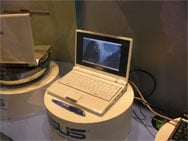
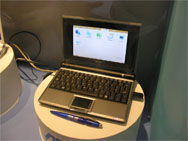
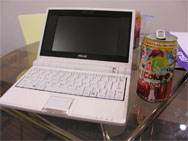
Being a UMPC cum Intel Classmate PC product, by default, the Eee's main competition is Negroponte's OLPC, which originally aimed to bring to market a laptop priced at $100 for children in developing countries. However, after much delays and a price increase to the $170 range, the OLPC has yet to be delivered. In the interim, the Eee might actually become available in two months.
The Eee is running a version of Intel’s 910 mobile chipset, it uses a 900MHz Intel Dothan based Pentium M CPU, and comes with 512MB of DDR2 memory, full 802.11g wireless capability, and a flash-based hard drive. There will be at least two different models of the Eee, with the $199 version using a 4GB flash drive and the $299 version using a 8GB drive.
Although 4GB of storage is extremely small when you consider desktops these days ship with 750GB drives on the notebooks with 200 GB drives, the 4GB flash drive keeps costs very low, and cheap external storage can very easily be added to the Eee PC.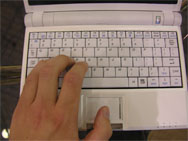
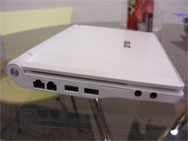
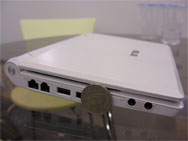
One of the first things that you notice about the ASUS Eee PC 701 is the fact that it is so light. The Eee PC weighs in at only .89 kilograms or around 2 pounds. The keyboard is slightly crammed and smaller than most notebook keyboards due to the smaller form factor. It very closely resembles the size of the keyboard used in the Dell Inspiron 710, which makes it ideal for emails, web surfing, or short papers, but could become a nuisance when writing for extended periods of time and for those that are used to full-sized notebook and desktop keyboards.
On the Eee PC’s left side panel, the notebook has two USB 2.0 ports, an audio and microphone port, a 10/100 Ethernet port, and a 56K phone modem port.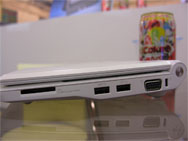
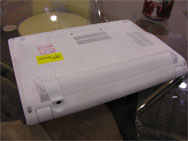
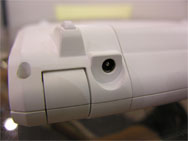
The right side panel of the Eee PC 701 has two more USB 2.0 ports (that is a total of four USB ports!), a VGA output, and even a flash card reader. The notebook uses a 4 cell battery that gives it just around 3 hours of battery life when it is on the move. As you may have noticed, there are no optical drives included with the Eee PC, and there is no room to add any to the notebook itself, so any DVD burners will have to be installed externally through one of the USB ports.
Heat wise, the Eee PC 701 feels a bit warm to the touch. It was however very quiet and the lack of spinning hard and optical drives made for a near silent experience.
The following is part of the review from HotHardware:
The ASUS Eee PC: First Look at Linux
Due to the fact the ASUS Eee PC 701 is aimed at booth computer novices and experts alike, there are two basic GUI designs included with its built-in Linux operating system. The first of which is called “Easy”, which as you might guess, is targeted at first time, or novice computer users.
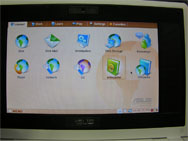
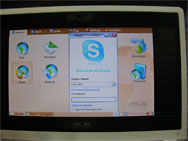
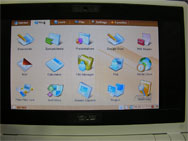
In Easy mode, there are six tabs: Internet, Work, Learn, Play, Settings, and Favorites. Each of these tabs has icons that can link to a website, file, or application on the Eee. The internet tab has a few interesting links, one to web storage, one to Wikipedia, and even one to Skype. The Eee PC 701 will likely have Skype pre-installed, and coupled with the notebook’s onboard webcam and microphone, will open up VOIP communications to an entire new set of users.
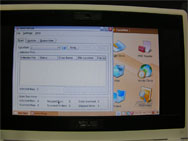
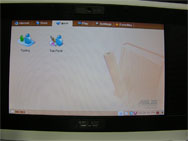

The Work tab opens up 15 different applications, ranging from standard Office-type software to a dictionary. The documents, spreadsheets, and presentations icons all lead to their respective applications in the free, open source office software suite Open Office. The Eee PC even comes with its own Anti-Virus software and in the learn section, has a typing and a painting program. Asus plans to include more open source education-related software when the Eee PC hits the market later this year, but didn’t give any more information on specific titles.
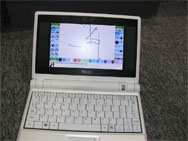
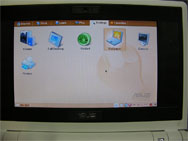
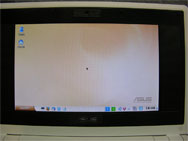
According to ASUS representatives, Standard mode was made to be “Windows-like” and looks and feels just like a typical Windows OS. The Windows Start button is replaced by a Launch icon, and navigating through files and applications is just like Windows. Even the minimize, maximize, and close buttons in the top right of each application window on the Eee PC 701 look identical to that of the Windows XP Silver style theme we run on our own standard notebooks. It seems as though ASUS is trying to bring as much “Windows-like” functionality to the Eee as they possibly can. With Windows in mind, ASUS has said that the Eee has already been tested to work on Windows XP, but to keep costs down it will not come pre-installed on the Eee.
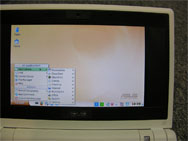
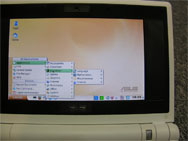
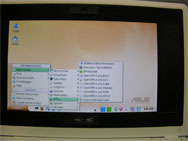
The ASUS Eee PC is expected to be available, worldwide, in full production quantities by this fall. It is rumored to have a street date of mid-August, and will likely be one of the hottest selling computers in recent history, come the holiday shopping season.
----------
From the looks of it, the Eee PC will function much like a web appliance. Guess we better start thinking of appropriate apps to develop from this perspective.
Labels: Asus Eee PC 701
Thursday, June 14, 2007
Is wireless [Wi-Fi-based] VoIP worth the bother?
From Network World -
Per the article, the answer for enterprise deployment is generally negative. However, recent trends provide hope.
Morever, successful deployments though still rare at this time, such as Osaka Gas in Japan, provide compelling proof of VoIP's viability. The utility used Meru Networks’ USD10M WLAN infrastructure to support 6,000 mobile phones that were equipped with cellular and Wi-Fi network interfaces.
The reluctance to embrace large-scale wireless VoIP isn’t suprising. Enterprisewide wireline VoIP deployments have only fairly recently found traction, and many of these have been angst-ridden. To be fair, often the angst is created by specific issues or problems at a given enterprise site.
But using a wireless connection in place of a wire adds lots of complexities, solutions to which are only slowly maturing. Access points have to be pervasively distributed to support voice traffic, while radio interference can easily affect voice quality or call sessions. Wireless eavesdropping on unsecured VoIP sessions is another worry for enterprise managers.
And it’s difficult to pinpoint savings since corporate IT doesn't have a good handle on actual spending since some of the equipment have other functions. Thus it is often just expensed, making it difficult to make a case for savings and therefore to make a case for investing in VoIP over WLAN.
Over the course of three months WLAN switches and access points from Aruba Wireless Networks, Chantry Networks (now Siemens), Cisco and Colubris Networks in terms of audio quality QoS enforcement, roaming capabilities, and system features were tested. Among the findings:
* With QoS enforcement turned on, and with only voice traffic on the net, calls nearly matched toll-quality audio.
* With even a small amount of data traffic, dropped calls became common and audio quality was poor, even with QoS still enabled.
* Roaming from one access point to another either failed or took so long, from 0.5 to 10 seconds, that calls dropped.
Those findings reflect some of the experience at Dartmouth College, which deployed a limited VoIP system on its pervasive Aruba-based campus WLAN four years ago. Initially, some college staff used the wearable mobile VoIP phone from Vocera. There were some problems with roaming, according to David Bucciero, Dartmouth director of technical services, who despite these teething pains is one who says wireless VoIP is worth the hassle.
More recently, the college has added just under 100 Cisco 7920 wireless VoIP handsets which “were flawless,” though latency was an issue early in the deployment. Reducing those delays has been an ongoing tuning process.
Things have changed in two years, including the advent of the 802.11e QoS standard, augmented by continued proprietary QoS tweaks, and faster handoffs between access points.
But the real change has been the growing interest in, and products for, shifting call sessions automatically between cellular and Wi-Fi. At the enterprise level, this convergence entails an IP PBX, usually a SIP server, the WLAN infrastructure, new specialized servers from start-ups like Divitas and established players like Siemens, and accompanying client code running on so-called dual-mode handsets.
Dartmouth is doing exactly this, running a pilot test with the Nokia E61i which uses SIP to talk to the Cisco CallManager IP PBX.
“Cellular and Wi-Fi convergence is the real pull for VoIP over wireless LANS,” says Farpoint’s Mathias. “Once that [convergence] happens, then we can converge dialing directories, voice mail, other services, and have one phone that works everywhere.”
Labels: VoIP
MiniOne, the telephone by Meizu
From Akihabara News -
The MiniOne is a GSM/EDGE/WCDMA Windows Mobile 6 phone equipped with an ARM11 533MHZ (SamSung) processor with 128MB DDR SDRAM.
Other features include:
- TFT Touch Screen (16M colors) 720x480 resolution
- 2 cameras (front 0.3Mpix/rear 3Mpix).
- BlueTooth
- Wifi,
- DMB Tuner
- Optional GPS
- Optional video output
- supports Avi, Mpeg4 and Wmv in 720x480.
- Memory is from 4 to 16GB a
- Price is from 190 (240) to 330€, that is from 260 (325) to 450$.
Note to myself - yet another Windows Mobile 6 device.
Labels: Mobile Phones
Asus EEE being advertised now!
From Philippine-based on-line retailer PC Corner's website -
"EeePC 701 Specification:
Display:7in.
CPU & Chipset: Intel® mobile CPU & chipset
OS: Linux/ Microsoft® Windows® XP compatible
Communication: 10/100Mbps Ethernet; 56Kb modem
WLAN: WiFi 802.11b/g
Graphic: Intel® UMA
Memory: 512Mb, DDR2-400
Storage: 4Mb / 8Gb / 16Gb Flash
Webcam: 300Kb pixel video camera
Audio: Hi-Definition Audio CODEC; Built-in stereo speaker; Built-in microphone Battery Life: 3hrs (4 cells: 5200mAh, 2S2P)
Dimension & Weight: 22.5 x 16.5 x 2.1~3.5cm, 0.89Kgs
An Easy Price to Swallow:
Shih also stated that ASUS plans to start shipping the units in July or August, with a target of selling 200,000 units this year – all under the ASUS brand. Amid gasps from the audience, the Eee PC units were revealed to come in at an extremely competitive price of around sub PhP 15K for the 7in. units, and about PhP 20K for the 10in. version.
Coming Soooonnnnnnnn...our BIG apologies for posting an item without definite date (ETA).. .just for excited seeing the specs and pricing. . .AFTER LEARNING FROM A FRIEND who just got back from the latest Taiwan Computex
storage configurations as follow:
04MB Flash----------> 13,999.00 (kinda low, but yes ! it is only 4MB... internal)
08GB Flash ----------> 15,999.00
16GB Flash ----------> 17,999.00
addendum: please wait further for actual final configuration...
official words from our local distro to come out mid June 2007..."
Huh??? I thought the 16GB Flash will go for USD300. At an exchang rate of PhP46 to USD1, it will be priced at USD391.28 - almost USD100 above the projected list price. Arrrrrrrrrrrrrrrh! Not an easy price to swallow. Well I am still excited about the specs. But the price? Hmmm. Gotta search the net more...
Labels: Asus Eee PC 701, Mobile Devices
Wednesday, June 13, 2007
5 ways iPhone will change the wireless biz
It appears Steve Jobs' WWDC keynote speech in which he revealed his game plan to irreversibly change the wireless world impressed both Om Malik and his co-author Tom T. Ahonen.
For his part, Ahonen believes the mobile telecoms world will now count its time in two Eras - the Era BI: time Before the iPhone, and the ERA AI: time After the iPhone. He also believes that even media business should be very very worried about iPhone.
While no one knows for sure how many million units of the iPhone Apple will sell – 5 or 10M in the first year, an insignificant number when compared to over 950M phones shipped worldwide every year, it will challenge some of the conventional notions of the wireless business, take the hidebound industry by the scruff of the neck and give it a good shake. Nokia will join Microsoft and Dell in experiencing Apple envy.
Om Malik is predicting the following for the iPhone:
A true web applications platform for the mobile
“We have been trying to come up with a solution to expand the capabilities of the iPhone so developers can write great apps for it, but keep the iPhone secure,” he said. “… And we’ve come up with a very innovative new way to create applications for mobile devices… it’s all based on the fact that we have the full Safari engine in the iPhone. And so you can write amazing Web 2.0 and AJAX apps that look and behave exactly like apps on the iPhone, and these apps can integrate perfectly with iPhone services.” (Steve Jobs keynote at WWDC via Engadget.)
Charles Ying thinks that Apple just reinvented the mobile applications platform. “This isn’t mobile Flash, mobile Java, or even the mobile Web. It’s the real Web, the real deal,” he writes. (True web should also mean 3G and not pokey EDGE connections that the device currently offers, one major Achilles heel of this device.) The ease, with which developers can develop and deploy apps on both web and the phones, will put pressure on other companies (and OS vendors) to play catch-up or lose developer attention.
Break the Wireless Walled Gardens
iPhone is a fully functional iPod, with full tracks of music. Do you need to download ring tones for $2.99 a pop, when you get a full song for a third of that price? Ditto for Wallpapers, and themes, and everything else that is being sold on the carrier deck.
Shift of control to the customers
If the embedded (Safari) browser performs the way as hyped, it will give us the choice-control we have on the web. Search engines to web sites – nothing will be determined by the wireless carriers who have thus far done nothing but create barriers between what we want, and giving us what they want to sell.
Slow demise of subsidized, boring phones filled with bloat ware
The introduction of the unlocked iPhone will do two things – it would basically get US buyers savvy to the idea of buying full priced unlocked phones. Secondly, it is going to cause a behavior change - of buying phones instead of freebies. (Will iPhone save the handset business?)
Keep it simple or else
One of the lasting changes that iPhone will bring to the mobile market is simplification. Their new UI is going to make complex mobile services relatively simple, and can have the same impact as Blackberry had on the corporate market.
Labels: Industry Analysis, iPhone
No iPhone SDK Means No Killer iPhone Apps
Edited commentary by Fast and Furious of Gizmodo -
According to Apple, no software developer kit is required for the iPhone. However, the truth is that the lack of an SDK means that there won't be any killer app the iPhone. It also means the iPhone's potential as an amazing computing and communication platform will never be realized.
Steve Jobs initially sold the iPhone as the Next Big Thing from Apple, just like the Mac was. The Mac really broke the mold. While not as groundbreaking, the iPhone is an intelligent and clean implementation of existing things. Really intelligent, really clean, like the Mac. Unlike the original Mac, however, developers won't have full access to its core features. Without them there won't be the equivalent of PageMaker, Photoshop, Word or Premiere in the iPhone, powerful applications taking full advantage of the unique capabilities of the hardware, the operating system and its frameworks.
Those applications spawned two revolutions: desktop publishing (including photo editing) and desktop video. It was the Mac and its third-party apps that brought radical changes that have deeply affected us, not the Mac alone.
On the iPhone, however, developers will be limited to developing Web applications based on AJAX, a set of Internet standards that make software like GMail, Google Maps or FaceBook possible. The iPhone is the real thing, a complete UNIX-to-go with stunning graphic classes, and developers will be limited to do stuff like this.
Mind you, AJAX is great for what it does on the Web today, but is limited.
Developers can create Web 2.0 applications which look and behave just like the applications built into iPhone, and which can seamlessly access iPhone's services, including making a phone call, sending an email and displaying a location in Google Maps.
This is nothing new, however. We knew this from the very beginning because iPhone's Safari was already doing it. It's called auto-detection of phone numbers and addresses: you click on a phone or address in your web page and it gets passed by Safari to the operating system, which calls the number or shows the address in the Google Maps app. In other words, they are trying to sell us the same thing we already had when the iPhone was introduced and the same thing we already have in Mac OS X's Safari.
So unless they show something boomtastic in the sessions, this will not change. To see how powerful AJAX applications on the iPhone could be, a million questions will have to be answered this week. Questions like:
- Would I be able to access the iPhone databases from Safari and query them from my AJAX application? Looking at Jobs' stress on security, it doesn't look like this will be possible.
- Would I be able store data locally beyond cookies? Probably the same answer.
- How will these application perform over limited EDGE connections? Will I have to do a painful download for the whole app, instead of just the data?
- How will the connection limit the interactive possibilities?
- How is the access to iPhone's hardware? Would I be able to access iPhone's hardware to connect to an infrared scanner via Bluetooth and create an amazing sales or logistics application? How about Multitouch?
If AJAX is that good and the developers don't need an SDK, why has Apple built a dedicated Mail application or Google Maps software into the iPhone? Why not just reformat the CSS on the Web and open a special view to .Mac mail, Gmail or Google Maps made just for iPhone Safari users ?
Maybe because to do the cool stuff that iPhone's Maps do, you need to access all the cool Mac OS X classes that iPhones have.
Now, I'm sure that there will be great AJAX applications created for the iPhone, specially at the corporate level. But what is important here is that we won't have sexy apps. This is what Apple needs to make the iPhone not just great, but huge. A true revolutionary product. Otherwise, we will keep asking where are we going to find the killer apps that made the Mac what is today; where is the next Delicious Library-equivalent for the iPhone; where are the games. Just think about those, as Apple stresses its relationship with EA and id software. There's a great potential for games in the iPhone, which with multi-touch could be a Nintendo DS 2.0 in the making. As Nintendo fans will tell you, a Flash game (which provides with even better flexibility than AJAX) is not a substitute for a real Wii game. And the next big games never come from the established big developers who may, at the end, be the only ones with access to the secret iPhone SDK at use in Apple.
So no SDK means no access to iPhone's cool frameworks which means no revolutionary apps, no real new concepts coming from third-parties, no eye candy available for anyone but Apple and no possibility for some really crazy games that will fully exploit the graphic and multi-touch power of the iPhone.
----------Guess we will have to make do with Flash Lite games and Safari plug-ins.
Labels: iPhone
Tuesday, June 12, 2007
Nokia E90 launch this week, entirely new type of mobile next year
Came across this undated post from Unwired View (probably very recently) since the Nokia N77 was just released -
In addition to the launch of the N77, the Nokia E90 Communicator is being launched in Finland this week as well.
According to the interview given to E24.se news portal by Antti Vasara, GM of Mobile Devices Business Unit, the E90 will start shipping in small quantities first in Finland, then Indonesia and will eventually reach Sweden this August. When the rest of us will see it is still not clear, since, according to Mr. Vasara, the E90 is a complicated piece of equipment and hard to produce in large quantities at first.

Other interesting bits of information revealed in the interview:
- Nokia is not too enthusiastic about touchscreens, since all their tests had shown that users prefer keyboard and joystick for an input device. But they are ready for touchscreens if they see the demand.
- Consumers don’t like to learn using new shapes/form factors on mobile phones. That’s why the E70 isn’t selling well.
- Nokia will be launching an entirely new type of mobile next year
Labels: Nokia
Apple announces third-party software details for iPhone
From Engadgetmobile -
Apple used WWDC as the stage to announce a third-party development solution for the iPhone, putting to rest concerns that the handset would be a closed platform. Calling it a "sweet solution" for developers to get their wares onto iPhones across the globe without sacrificing stability or security, Apple is using its full Safari-based browser to let folks code up true, Web 2.0-compatible apps that can be accessed and updated on developers' own servers. Though any apps that third-party developers put together will run under Safari, they'll be totally customizable and maintain the platform's unique look and feel. Better yet, they won't require any special SDK -- Jobs claims that a working knowledge of modern web standards is all we'll need to code up custom iPhone goodies to our hearts' content.
Labels: iPhone
Nokia N77 Multimedia Computer Starts Shipping
Edited Press Release from Nokia
ESPOO, Finland, June 11 - Finland is the first to experience optimized mobile TV with the Nokia N77 multimedia computer. Later this month also Vietnam and India will start shipments of the Nokia N77. Consumers will now be able to keep up to date with news and sports and enjoy their favorite TV shows live on the move*. The affordable Nokia N77 comes in a stylish and pocketable form factor with complete Nokia Nseries functionalities.
"The Nokia N77 takes TV out of the living room," said Jonas Geust, head of Nokia Nseries Players Category, Multimedia, Nokia. "The wide 2.4" flat screen and high quality stereo sound makes it the ideal personal mobile device for enjoying TV programs on the go."
The dedicated TV key on the Nokia N77 gives users direct access to a world of TV programs. It even remembers the last channel viewed when switched off the TV. Viewers can also set reminders to alert when a program is starting and access it at the push of a button.
The Nokia N77 also offers the advantage of 30 second replay and live TV watching continues after the replay clip. Through the Program Guide in the mobile TV application viewers can see program information up to seven days, browse TV channels, purchase new channels if desired and select the TV program they are interested in.
Other features include MP3 player, 2MP camera (1600 x 1200 pixels), web browsing, email access, calendar and to-do lists.
The Nokia N77 is based on S60 3rd Edition software on Symbian OS and is offered in markets where commercial mobile TV services based on DVB-H technology are available.
Labels: Nokia
iPhone Details from AT&T's Sales Training Workbook
From MacRumors -
The guide presents iPhone features and benefits, tips, comparisons, qualifying questions, and objections. Among those listed are:
Revolutionary Mobile Phone
- Dial any telephone number with the touch of a finger
- Create and manage a list of telephone numbers you call most
- If you choose to answer the call, the video will pause and resume once the call ends
- iPhone syncs contact information from the computer to iPhone (from Address Book on a Mac or Outlook or Outlook Express on a Windows PC).
- Built-in speakerphone
- iPhone lets you carry on a phone conversation while you simultaneously browse the Internet or send an email.
- There is a vibrate mode.
Photos
- Sync photos from Mac or PC
SMS Text Messaging
- SMS text message button shows how many new messages are waiting
- Threaded conversations
- Hear an audio alert for new messages
- Error correction and prevention in the keyboard. Only displayed when you need it.
- iPhone users will not be able to conduct IM conversations with instant messaging users
- Does not support MMS messaging for photos or videos
Music and Video
- All videos play in landscape mode
- If you prefer your widescreen content to take up the entire screen, you can double tap the video and iPhone will automatically scale the video to take up the entire screen
- Sync music with iTunes just like any other iPod
- Select how to display music: by playlist, artist, songs or more.
- Media Net, MobiTV, or Cellular Video are not available on iPhone
Email
- Rich formatting
- Support for IMAP and POP3
- Yahoo! Push Mail
- Automatic address completion
Safari
- Double tap an object to make it fill the screen, and double tap to zoom out
- Can have multiple websites open at once and switch between them
- Websites you have bookmarked on your computer will be transfered to your iPhone from your Mac or PC
Google Maps
- iPhone will not support the TeleNav solutions currently offered by other AT&T devices
- GPS is not part of the iPhone feature set.
Labels: iPhone
HTC Touch
From Unwired -
LAUNCH: HTC Touch to make Asian debut in Taiwan
HTC Corp. today announced that the HTC Touch will make its Asian retail debut in Taiwan. The new HTC-designed homescreen provides one-touch access to E-Mails, text messages, calendar appointments, and contacts, as well as current weather conditions and forecasts for hundreds of cities around the world.

The HTC Touch is the first device to feature TouchFLO, a 3D user interface that allows users to move through on-screen options by sweeping their fingers across the screen, or scrolling up and down using a fingertip. Users simply slide their finger on the display to launch an animated interface comprising three screens: Contacts, Media, and Applications. The interface can be spun by swiping a finger right or left across the display, providing efficient access to the features consumers use most. TouchFLO also enhances finger touch scrolling and browsing of Web pages, documents, messages and contact lists. The interface has even been programmed to intelligently distinguish between finger and stylus input and then responds accordingly.
HTC has selected Chunghwa Telecom, Taiwan's largest telecommunications operator, as its exclusive partner in retailing the HTC Touch, and the device will be made available to consumers island-wide beginning in mid-June.
Running Windows Mobile 6 Professional, the HTC Touch includes Outlook Mobile, Office Mobile, Windows Live and the capabilities to run thousands of third-party applications. Users can surf the web with Internet Explorer, send and receive E-Mails, chat on Messenger and send files to their own web space through Windows Live.
Labels: Mobile Devices
Saturday, June 9, 2007
Asus Eee PC 701
 The initial reported specs of the Asus Eee PC701 include:
The initial reported specs of the Asus Eee PC701 include:
Intel Mobile CPU, 802.11b/g WiFi, Ethernet, modem, webcam, 512MB of RAM and a 4, 8 or 16GB flash drive for speedy, reliable storage, with a weight of 2 lbs.
But what got me interested was the price. At a reported USD200, it would be cheaper than a high-end Nokia phone! Or a high-end portable DVD player.
Now Engadget Chinese reportedly has managed to get its hand on a unit and has dug up a few more details on it. Windows XP has been successfully tested but the final product will likely come with Linux, with XP driver support thrown in for good measure. In addition it could eventually pack as much as 32GB of SSD storage, and possibly either an optional built-in or dongle 3G module. Asus also reiterated that seemingly too good to be true USD200 starting price, with a version for "English speaking countries" available as early as August this year.
Hmmm, this might just replace my old trusty Fujitsu P7010 as my portable surfing machine. Well, hopefully it will do more than that but at USD200, I shouldn't really be complaining, especially if it comes with a built-in 3G module. I guess we will see.
Labels: Asus Eee PC 701, Mobile Devices
Introduction
More than just a public diary, I am setting up this blog more as a convenient on-line repository of pertinent information (and personal analysis) for myself. I will be posting news/references to various products, services, or trends. I may or may not add my comments/analysis at the time of my original posting. Or I may add them in the future. Thus, this blog is not meant to be read chronologically. Instead it meant more as an on-line reference for specific subject matters.
